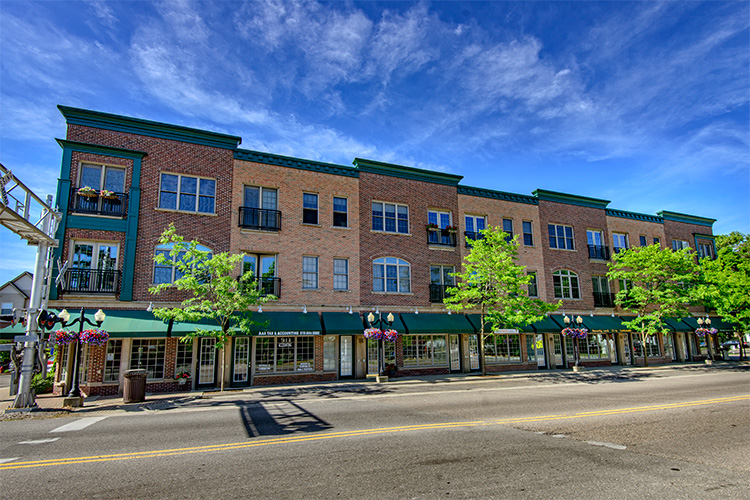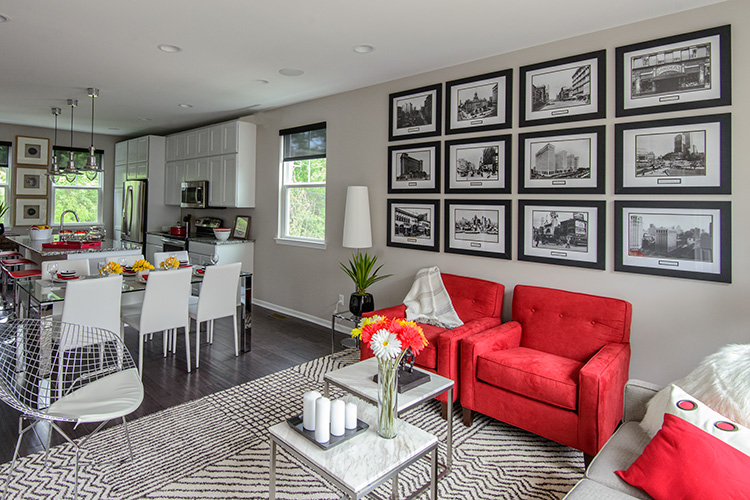For better or worse, the Great Recession brought about a slew of changes in the way many Americans live. But in Metro Detroit, as in most of the rest of the nation, the housing market has yet to respond to some of those shifts.
Wayne State University urban planning professor Robin Boyle describes a "polar division" in housing styles in the region, from the denser urban style of large apartment buildings to the suburban style of detached single-family homes.
But, he says, there are plenty of other housing types that fall in between those two categories. These incude architectural styles which maintain a detached home's sense of scale while also allowing higher residential density: duplexes, triplexes, townhomes, two- and three-flats, apartment courts and more.
Housing Types in Macomb, Oakland, Washtenaw and Wayne Counties
2010-2014 American Community Survey 5-Year Estimate
In 2010, California architect Daniel Parolek coined the term "missing middle" to describe these housing types—"missing" because developers simply don't tend to build them. U.S. Census data shows that 648,000 single-family homes and 320,000 multi-family units were completed nationwide last year. Ninety-nine percent of the multi-family units were conventional apartments, 45 percent of them in buildings with 50 units or more.
According to developer Shannon Morgan, those building practices are "obsolete." Morgan is senior vice president of Farmington Hills-based HRS Communities and a member of the nonprofit Urban Land Institute (ULI) Michigan. She says most of Metro Detroit's housing stock is based on post-World War II development practices.
"After World War II we had people that were getting married, having families and moving to the suburbs looking for schools," she says. "That's the way we built the houses throughout the generations. But this generation has changed quite a bit. In Michigan, we don't have housing that reflects this generational shift."
An emerging market
A broad range of current trends now pushes Americans towards housing that doesn't fit the post-WWII mold. We've all heard about how much less likely millennials are to purchase a home, closely linked to their tendency to remain unmarried longer than previous generations. But this shift isn't driven just by millennials—
baby boomers, too, are increasingly seeking slightly smaller housing units as their nests empty.
And as they seek housing, both generations share an interest in living in the midst of a walkable urban core—quite different from that post-WWII model.
"They are buying based on lifestyle selection," Morgan says. "They want to move to a city that has amenities, where they can walk and bike and have access to restaurants and shops. They're looking more for the experience."
Boyle says that while developers tend to fall back on the housing styles they're familiar with, some in Metro Detroit are beginning to take notice of shifting demands in the market.
"They're seeing what's happening in Detroit, and they also know that there's demographic change," Boyle says. "There's clearly pressure coming."
Morgan, for example, has found great success with townhome communities in Detroit,
Birmingham, and
Brighton. In addition to interest from millennials and empty-nest baby boomers, she's also found considerable crossover between those two markets in families seeking multi-generational housing.
 Main Street live-work lofts. Photo by Doug Coombe.
That includes not only the much-documented trend of millennials moving back in with their parents, but the newer trend of parents and children shopping for and purchasing housing together
Main Street live-work lofts. Photo by Doug Coombe.
That includes not only the much-documented trend of millennials moving back in with their parents, but the newer trend of parents and children shopping for and purchasing housing together.
"We're finding right now a huge demand for multi-generational housing, and almost no product," Morgan says.
James Clarke, president of Milford-based Robertson Brothers Homes and a member of ULI Michigan, has also found success with missing middle housing. Robertson Brothers' Sherman Oaks townhouse development in Royal Oak is sold with only 75 percent of the development built out. The company's
Kilmer Place townhouse development in Troy sold out in 2014.
"A lot of our buyers are young professionals who are coming out of apartments and/or first-time homeowners," Clarke says. "They want the convenience of condominium living as opposed to single-family homes. It's both a price and a lifestyle decision."
Clarke says he has three more missing middle-style communities in the works in Royal Oak and Troy. Robertson Brothers also purchased Ferndale Public Schools' former Taft Digital Learning Center site in May with intentions to build a 60-townhouse development there.
Although Clarke says he wouldn't pursue such developments in further-flung communities where more buildable land is available, he can't get enough of missing middle-style developments in the inner metropolitan area.
"There is a shortage in markets like Detroit, in Royal Oak, in any of the inner-ring communities where people want to be," Clarke says.
Challenges to building the "missing middle"
 Sherman Oaks in Royal Oak. Photo by Doug Coombe.
Clarke and Morgan are among only a few area developers beginning to aggressively pursue missing middle developments. Asked for examples of missing middle developments in the metro area, Boyle drily comments "it's easier to tell you the stuff that hasn't worked."
"I wish I could point you into the first-ring suburbs
Sherman Oaks in Royal Oak. Photo by Doug Coombe.
Clarke and Morgan are among only a few area developers beginning to aggressively pursue missing middle developments. Asked for examples of missing middle developments in the metro area, Boyle drily comments "it's easier to tell you the stuff that hasn't worked."
"I wish I could point you into the first-ring suburbs—Royal Oak, Ferndale, Oak Park—and show you a 'missing middle' housing development that has occurred on their gap sites," he says. "It's not happening yet. I think there's a lot of people who are interested, but it hasn't happened yet."
One metro area developer, Ann Arbor's McKinley Inc., considers missing middle housing its entire business plan in certain markets. But not here in Michigan. McKinley CEO Albert Berriz says his company has focused on developing missing middle housing, mostly through rehabilitating older buildings, in Tampa Bay and Orlando, Florida.
"They're sought after," Berriz says. "The duplex, the four-plex, the 12- to 16-plex, particularly in urban infill locations, can be a less expensive alternative to the brand-new high-rise."
In Ann Arbor, where most of McKinley's Michigan inventory is concentrated, Berriz says most potential missing middle units are already devoted to University of Michigan student housing. But Morgan says other issues are holding metro area missing middle housing back as well—particularly zoning restrictions that prevent the slightly higher density such developments entail.
"You're not going to get too many people that will spend the time and effort to get something re-zoned or work with municipal governments to change codes or laws," she says. "So cities need to invest in good planning initiatives. It's key if they want to attract developers."
Boyle notes that that kind of zoning change often draws pushback, and is likely to bring even more resistance if missing middle housing starts to take off. A recent example of this is evident in the City of Berkley's rejection of a form-based code proposal that would have increased density in the city near single-family residential neighborhoods. Public outcry pushed city leaders to drop the idea.
Particularly in areas where single-family homes predominate, Boyle says the proposition of denser developments often raise concerns that are rooted in race and class issues.
"People are just reluctant to see that change," Boyle says. "But there is market demand and this is a product that's missing. The question is, will there be sufficient pressure from the development industry, from developers and the architects, to see if the zoning system can be loosened up to accommodate this?"